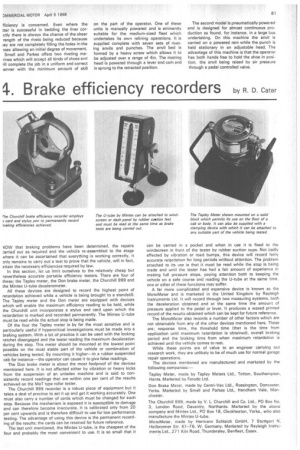I-. Brake efficiency recorders by R. D. Cater
Page 83

If you've noticed an error in this article please click here to report it so we can fix it.
VOW that braking problems have been determined, the repairs 3arried out as required and the vehicle re-assembled to the stage mhere it can be ascertained that everything is working correctly, it DnI y remains to carry out a test to prove that the vehicle, will in fact, attain the necessary efficiencies required by law.
In this section, let us limit ourselves to the relatively cheap but ievertheless accurate portable efficiency testers. There are four of these; the Tapley meter, the Don brake meter, the Churchill 999 and the Mintex U-tube decelerometer.
All these devices are designed to record the highest point of retardation achieved while a vehicle is being brought to a standstill. The Tapley meter and the Don meter are equipped with devices which will enable the maximum efficiency reading to be held, while the Churchill unit incorporates a stylus and card upon which the retardation is marked and recorded permanently. The Mintex U-tube must be read while the actual stop is being made.
Of the four the Tapley meter is by far the most sensitive and is particularly useful if hypercritical investigations must be made into a braking system. With a bit of practice it can be used with the locking ratchet disengaged and the tester reading the maximum deceleration during the stop. This meter should be mounted at the lowest point possible on the most stable part of the vehicle or combination of vehicles being tested. By mounting it higher—in a rubber suspended cab for instance—the operator can cause it to give false readings.
The Don brake meter is about the most foolproof of the devices mentioned here. It is not affected either by vibration or heavy kicks from the suspension of an unladen machine and is said to consistently record readings that are within one per cent of the results achieved on the MoT type roller tester.
The Churchill 999 recorder is a robust piece of equipment but it takes a deal of practice to set it up and get it working accurately. One must also carry a number of cards which must be changed for each stop. Because the mechanism is exposed it is susceptible to damage and can therefore become inaccurate. It is calibrated only from 20 per cent upwards and is therefore difficult to use for low performance testing. The advantage of using this device is the permanent recording of the results; the cards can be retained for future reference.
The last unit mentioned, the Mintex U-tube, is the cheapest of the four and probably the most convenient to use. It is so small that it can be carried in a pocket and when in use it is fixed to the windscreen in front of the tester by rubber suction cups. Not badly affected by vibration or road bumps, this device will record fairly accurate retardation for long periods without attention. The Problem attached to its use is that it must be read while the stop is being made and until the tester has had a fair amount of experience in making full pressure stops, paying attention both to keeping the vehicle on a safe course and reading the U-tube at the same time, one or other of these functions may suffer.
A far more complicated and expensive device is known as the MotoMeter and is marketed in the United Kingdom by Rayleigh instruments Ltd. It will record through two measuring systems, both the deceleration obtained and at the same time the amount of pressure applied to the pedal or lever. It produces a waxed printed record of the results obtained which can be kept for future reference, The MotoMeter also records a number of other factors which are not obtainable from any of the other devices mentioned here. These are; response time, the threshold time (that is the time from application until maximum retardation is obtained), overall braking period and the braking time from when maximum retardation is achieved until the vehicle comes to rest.
While these points are of value to an engineer carrying out research work, they are unlikely to be of much use for normal garage repair operations.
The devices mentioned are manufactured and marketed by the following companies:— Ta pley Meter, made by Tapley Meters Ltd., Totton, Southampton, Hants. Marketed by Ferodo Ltd.
Don Brake Meter, made by Centri-Vac Ltd„ Rossington, Doncaster, Yorks, Marketed by Small and Parkes Ltd., Hendham Vale, Manchester.
The Churchill 999, made by V. L. Churchill and Co. Ltd., PO Box No. 3, London Road, Daventry, Northants. Marketed by the above company and Mintex Ltd., PO Box 18, Cleckheaton, Yorks., who also manufacture the Mintex U-tube.
MotoMeter, made by Hermann Schlaich GmbH, 7 Stuttgart N, Heilbronner Str. 67-76, W. Germany. Marketed by Rayleigh Instruments Ltd., 271 Kiln Road, Thundersley, Benfleet, Essex.




























































































































































